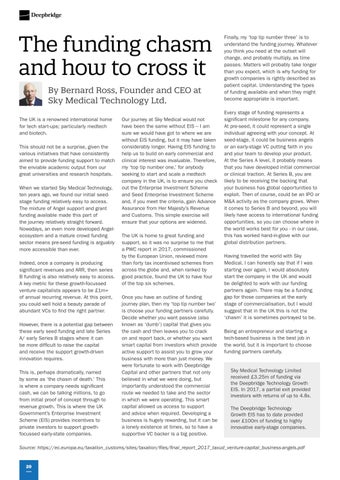The funding chasm and how to cross it By Bernard Ross, Founder and CEO at Sky Medical Technology Ltd. The UK is a renowned international home for tech start-ups; particularly medtech and biotech. This should not be a surprise, given the various initiatives that have consistently aimed to provide funding support to match the enviable academic output from our great universities and research hospitals. When we started Sky Medical Technology, ten years ago, we found our initial seedstage funding relatively easy to access. The mixture of Angel support and grant funding available made this part of the journey relatively straight forward. Nowadays, an even more developed Angelecosystem and a mature crowd funding sector means pre-seed funding is arguably more accessible than ever. Indeed, once a company is producing significant revenues and ARR, then series B funding is also relatively easy to access. A key metric for these growth-focussed venture capitalists appears to be £1m+ of annual recurring revenue. At this point, you could well hold a beauty parade of abundant VCs to find the right partner. However, there is a potential gap between these early seed funding and late Series A/ early Series B stages where it can be more difficult to raise the capital and receive the support growth-driven innovation requires. This is, perhaps dramatically, named by some as ‘the chasm of death.’ This is where a company needs significant cash, we can be talking millions, to go from initial proof of concept through to revenue growth. This is where the UK Government’s Enterprise Investment Scheme (EIS) provides incentives to private investors to support growthfocussed early-state companies.
Our journey at Sky Medical would not have been the same without EIS – I am sure we would have got to where we are without EIS funding, but it may have taken considerably longer. Having EIS funding to help us to build on early commercial and clinical interest was invaluable. Therefore, my ‘top tip number one,’ for anybody seeking to start and scale a medtech company in the UK, is to ensure you check out the Enterprise Investment Scheme and Seed Enterprise Investment Scheme and, if you meet the criteria, gain Advance Assurance from Her Majesty’s Revenue and Customs. This simple exercise will ensure that your options are widened. The UK is home to great funding and support, so it was no surprise to me that a PWC report in 2017, commissioned by the European Union, reviewed more than forty tax incentivised schemes from across the globe and, when ranked by good practice, found the UK to have four of the top six schemes. Once you have an outline of funding journey plan, then my ‘top tip number two’ is choose your funding partners carefully. Decide whether you want passive (also known as ‘dumb’) capital that gives you the cash and then leaves you to crack on and report back, or whether you want smart capital from investors which provide active support to assist you to grow your business with more than just money. We were fortunate to work with Deepbridge Capital and other partners that not only believed in what we were doing, but importantly understood the commercial route we needed to take and the sector in which we were operating. This smart capital allowed us access to support and advice when required. Developing a business is hugely rewarding, but it can be a lonely existence at times, so to have a supportive VC backer is a big positive.
Finally, my ‘top tip number three’ is to understand the funding journey. Whatever you think you need at the outset will change, and probably multiply, as time passes. Matters will probably take longer than you expect, which is why funding for growth companies is rightly described as patient capital. Understanding the types of funding available and when they might become appropriate is important. Every stage of funding represents a significant milestone for any company. At pre-seed, it could represent a single individual agreeing with your concept. At seed-stage, it could be business angels or an early-stage VC putting faith in you and your team to develop your product. At the Series A level, it probably means that you have developed initial commercial or clinical traction. At Series B, you are likely to be receiving the backing that your business has global opportunities to exploit. Then of course, could be an IPO or M&A activity as the company grows. When it comes to Series B and beyond, you will likely have access to international funding opportunities, so you can choose where in the world works best for you - in our case, this has worked hand-in-glove with our global distribution partners. Having travelled the world with Sky Medical, I can honestly say that if I was starting over again, I would absolutely start the company in the UK and would be delighted to work with our funding partners again. There may be a funding gap for those companies at the early stage of commercialisation, but I would suggest that in the UK this is not the ‘chasm’ it is sometimes portrayed to be. Being an entrepreneur and starting a tech-based business is the best job in the world, but it is important to choose funding partners carefully.
Sky Medical Technology Limited received £3.25m of funding via the Deepbridge Technology Growth EIS. In 2017, a partial exit provided investors with returns of up to 4.8x. The Deepbridge Technology Growth EIS has to date provided over £100m of funding to highly innovative early-stage companies.
Source: https://ec.europa.eu/taxation_customs/sites/taxation/files/final_report_2017_taxud_venture-capital_business-angels.pdf
20







